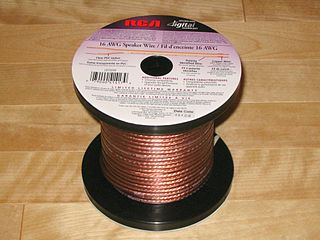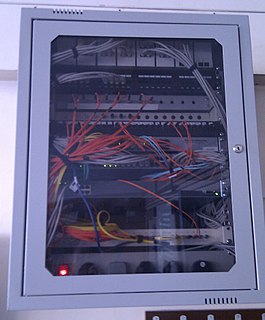In telecommunications and professional audio, a balanced line or balanced signal pair is a transmission line consisting of two conductors of the same type, each of which have equal impedances along their lengths and equal impedances to ground and to other circuits. The chief advantage of the balanced line format is good rejection of external noise when fed to a differential amplifier. Common forms of balanced line are twin-lead, used for radio frequency signals and twisted pair, used for lower frequencies. They are to be contrasted to unbalanced lines, such as coaxial cable, which is designed to have its return conductor connected to ground, or circuits whose return conductor actually is ground. Balanced and unbalanced circuits can be interconnected using a transformer called a balun.
Digital subscriber line is a family of technologies that are used to transmit digital data over telephone lines. In telecommunications marketing, the term DSL is widely understood to mean asymmetric digital subscriber line (ADSL), the most commonly installed DSL technology, for Internet access.

In telecommunications and computer networks, multiplexing is a method by which multiple analog or digital signals are combined into one signal over a shared medium. The aim is to share a scarce resource. For example, in telecommunications, several telephone calls may be carried using one wire. Multiplexing originated in telegraphy in the 1870s, and is now widely applied in communications. In telephony, George Owen Squier is credited with the development of telephone carrier multiplexing in 1910.

The T-carrier is a member of the series of carrier systems developed by AT&T Bell Laboratories for digital transmission of multiplexed telephone calls.

Time-division multiplexing (TDM) is a method of transmitting and receiving independent signals over a common signal path by means of synchronized switches at each end of the transmission line so that each signal appears on the line only a fraction of time in an alternating pattern. It is a communication process that transmit 2 or more digital signals or analog signals over a common channel>] It is used when the bit rate of the transmission medium exceeds that of the signal to be transmitted. This form of signal multiplexing was developed in telecommunications for telegraphy systems in the late 19th century, but found its most common application in digital telephony in the second half of the 20th century.

In telecommunications, frequency-division multiplexing (FDM) is a technique by which the total bandwidth available in a communication medium is divided into a series of non-overlapping frequency bands, each of which is used to carry a separate signal. This allows a single transmission medium such as a cable or optical fiber to be shared by multiple independent signals. Another use is to carry separate serial bits or segments of a higher rate signal in parallel.

A digital subscriber line access multiplexer is a network device, often located in telephone exchanges, that connects multiple customer digital subscriber line (DSL) interfaces to a high-speed digital communications channel using multiplexing techniques.
This is an index of articles relating to electronics and electricity or natural electricity and things that run on electricity and things that use or conduct electricity.

A balun is an electrical device that converts between a balanced signal and an unbalanced signal. A balun can take many forms and may include devices that also transform impedances but need not do so. Transformer baluns can also be used to connect lines of differing impedance. Sometimes, in the case of transformer baluns, they use magnetic coupling but need not do so. Common-mode chokes are also used as baluns and work by eliminating, rather than ignoring, common mode signals.
Hybrid fiber-coaxial (HFC) is a telecommunications industry term for a broadband network that combines optical fiber and coaxial cable. It has been commonly employed globally by cable television operators since the early 1990s.
In telephony, pair gain is the transmitting of multiple POTS signals over the twisted pairs traditionally used for a single traditional subscriber line in telephone systems. Pair gain has the effect of creating additional subscriber lines. This is typically used as an expedient way to solve subscriber line shortage problems by using existing wiring, instead of installing new wires from the central office to the customer premises. The term was invented in the middle 20th century by analogy with earlier use of gain to extend telephone local loops far from the telephone exchange.

A telephone line or telephone circuit is a single-user circuit on a telephone communication system. This is the physical wire or other signaling medium connecting the user's telephone apparatus to the telecommunications network, and usually also implies a single telephone number for billing purposes reserved for that user. Telephone lines are used to deliver landline telephone service and Digital subscriber line (DSL) phone cable service to the premises. Telephone overhead lines are connected to the public switched telephone network.

Digital access carrier system (DACS) is the name used by British Telecom in the United Kingdom for a 0+2 pair gain system.

Speaker wire is used to make the electrical connection between loudspeakers and audio amplifiers. Modern speaker wire consists of two or more electrical conductors individually insulated by plastic or, less commonly, rubber. The two wires are electrically identical, but are marked to identify the correct audio signal polarity. Most commonly, speaker wire comes in the form of zip cord.
Bridged tap or bridge tap is a long-used method of cabling for telephone lines. One cable pair will "appear" in several different terminal locations. This allows the telephone company to use or "assign" that pair to any subscriber near those terminal locations. Once that customer disconnects, that pair becomes usable at any of the terminals. In the days of party lines, 2, 4, 6, or 8 users were commonly connected on the same pair which appeared at several different locations.
High-bit-rate digital subscriber line (HDSL) is a telecommunications protocol standardized in 1994. It was the first digital subscriber line (DSL) technology to use a higher frequency spectrum over copper, twisted pair cables. HDSL was developed to transport DS1 services at 1.544 Mbit/s and 2.048 Mbit/s over telephone local loops without a need for repeaters. Successor technology to HDSL includes HDSL2 and HDSL4, proprietary SDSL, and G.SHDSL.

Fiber-optic communication is a method of transmitting information from one place to another by sending pulses of infrared light through an optical fiber. The light forms an electromagnetic carrier wave that is modulated to carry information. Fiber is preferred over electrical cabling when high bandwidth, long distance, or immunity to electromagnetic interference are required. This type of communication can transmit voice, video, and telemetry through local area networks, computer networks, or across long distances.

A DSL loop extender is a device that a telephone company can place between subscriber premises equipment and central office interfaces to extend the distance and increase the channel capacity of digital subscriber line (DSL) connections. ADSL repeaters are deployed by rural telephone companies trying to provide rural Internet service to farms and small towns where it is impractical to place the DSLAM closer to the subscriber. Typical distance improvements with a loop extender are shown in the diagram below, with rate in megabits per second and distance in thousands of feet.

Asymmetric digital subscriber line (ADSL) is a type of digital subscriber line (DSL) technology, a data communications technology that enables faster data transmission over copper telephone lines than a conventional voiceband modem can provide. ADSL differs from the less common symmetric digital subscriber line (SDSL). In ADSL, bandwidth and bit rate are said to be asymmetric, meaning greater toward the customer premises (downstream) than the reverse (upstream). Providers usually market ADSL as a service for consumers for Internet access for primarily downloading content from the Internet, but not serving content accessed by others.

A telephone exchange or telephone switch is a telecommunications system used in the public switched telephone network or in large enterprises. It interconnects telephone subscriber lines or virtual circuits of digital systems to establish telephone calls between subscribers.











